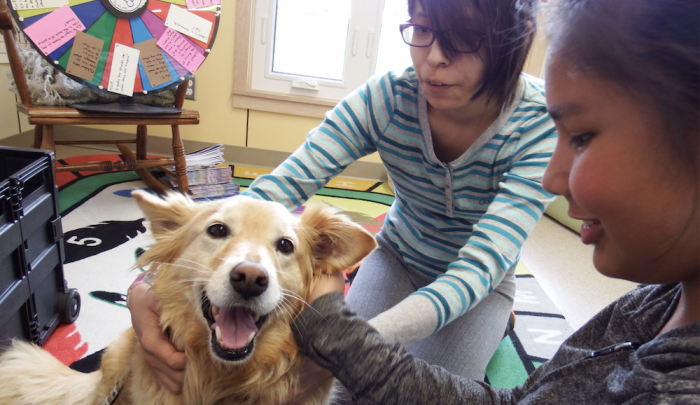The consumeristic hubbub of the holiday season can distract us from an encouraging point: it’s the most charitable time of year.
Here is some food for thought as fundraising campaigns fill our mailboxes and inboxes.
The average American nonprofit collects a third of its donations in December. Can you guess the percentage that flows to nonprofits that support animal welfare? The figure is a paltry one percent. Most of those funds go to warehousing unwanted companion animals.
So why should we support groups that work with “fuzzy kittens and puppies” when there are real human problems out there like hunger and violence? We have heard many similar questions in the 11 years we have operated an animal welfare group in our small northern town. Our community, like many others, suffers from issues like poverty, substance abuse, violence, and low levels of literacy. We must remember that when we help humans, we help the animals, and vice versa. That is, “and,” not “or.”
There’s an indisputable link between animal abuse and human violence. Improving the level of care and compassion for animals reduces bullying and other forms of violence. This is why humane education and guardian support programs are so important.
Families with hungry kids have hungry pets, and some folks will go without to feed their beloved furry family members. Pet food programs help keep everyone fed.
Overpopulation of companion animals causes many types of suffering. The animals suffer, and so do the humans who witness animal suffering. Overpopulation means a greater risk from dog bites. It promotes a culture of “disposability,” where animals are seen as a nuisance or danger, not valued as loving, feeling individuals.
Programs that assist with spaying and neutering contribute to a long list of benefits and help to “turn off the tap instead of mopping up the mess” (Jean Atthowe, Montana Spay/Neuter Task Force).
To see some examples of these types of programs and their remarkable effects in our community, check out our infographic.
Two-thirds of all donors—regardless of cause—do zero research before giving. Here’s to raising the bar.
The following tips and examples are focused on our experiences with animal welfare, but there are some useful points to consider for all charitable giving:
1) Consider supporting small, local groups.
Local groups understand local issues. They are more likely to have community connections and buy-in. There are many examples of “white knight” groups who swoop in only to have their initiatives fall flat due to lack of understanding of cultures or key players or local resources.
For example, you can have a generous spay/neuter voucher program set up with regional veterinary clinics, but what if people don’t have a car to transport their animals? What if they don’t have a phone to make appointments (yes, this can still be a problem in the 21st century)?
Small groups generally don’t have enough resources to support bloated overhead. They are far more likely to be powered by individuals with the sort of passion and energy that you will be hard-pressed to find in the private sector. Small groups tend to be able to respond more quickly and creatively to issues.
2) Follow the money and think critically about the big picture.
IRS charity reports with financial information are publicly available. Third-party services like Charity Navigator provide additional information and ratings.
The great thing about local groups is you can walk up to them on the street or at events and say, “Hey, tell me more about what you do and how you do it!”
Look for leverage. Find out how the organization stretches donor dollars. For example, in our partner program with the local food bank, we provide a steady supply of kibble for furry family members. But, instead of buying the food, we work with volunteers in the city to collect donations of pet food. A local transport company ships the pallets of food at a reduced rate. Each donor dollar yields about 20 dollars in pet food for families in need.
Look for the long view. The best groups will have a plan for how to work their way out of a job. In companion animal welfare, most donor money is spent on the aforementioned warehousing of animals. It is human nature to love stories about Fifi the one-eyed pug who was brought in off the streets, but warehousing doesn’t get at the root of the problem.
Allocating those dollars to spay/neuter programs and humane education would move us light-years ahead in preventing animal suffering. For the cost of sheltering one dog (roughly $750), you could fund several spay/neuter surgeries and prevent dozens of unwanted litters. You could deliver education sessions to hundreds of students who take materials and messages home to their families. It just doesn’t have the warm and fuzzy tangibility of helping a cat with a broken leg or getting naming rights on a fancy building.
3) It doesn’t take a cash donation to make a difference.
Large or small (but especially small), every animal welfare group relies on volunteer power. Unemployment is sitting at a historic low. We have never seen labor in such short supply. Nonprofits struggle to deliver services due to lack of volunteer power.
Any group worth their salt will find a niche for all prospective volunteers. Volunteer with business skills? Help with bookkeeping or administrative tasks. Marketing? Help with fundraising or rehoming programs. Crafty? Make toys or beds for animals, gifts for donors, or for sales. Love spending time with animals? Foster an animal, or get involved with socializing community cats or walking dogs. The list is endless.
Many nonprofits can be assisted through votes, petitions, testimonials, support letters, and positive word of mouth. In addition to helping in a practical sense, it is also critical for groups to know they are appreciated. It helps them fight fatigue and burnout.
Enough about being critical in our thinking and creative about solutions. Time to commit to action. Enduring happiness comes from doing good for others.
There are 365 days in the year, and Thanksgiving and Christmas are just two of them. Whatever causes we choose to support, let’s not just get involved for the brief holiday season. Let’s stay involved. Maybe then that “Christmas feeling” will indeed last throughout the year.
~
“Nothing gives me quite so much joy as when people tell me they’ve had their pets spayed or neutered.” ~ Bob Barker, who will turn 96 on December 12th












Read 1 comment and reply